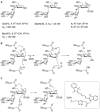Spiro-epoxyglycosides as Activity-Based Probes for Glycoside Hydrolase Family 99 Endomannosidase/Endomannanase
- PMID: 29797675
- PMCID: PMC6055899
- DOI: 10.1002/chem.201801902
Spiro-epoxyglycosides as Activity-Based Probes for Glycoside Hydrolase Family 99 Endomannosidase/Endomannanase
Abstract
N-Glycans direct protein function, stability, folding and targeting, and influence immunogenicity. While most glycosidases that process N-glycans cleave a single sugar residue at a time, enzymes from glycoside hydrolase family 99 are endo-acting enzymes that cleave within complex N-glycans. Eukaryotic Golgi endo-1,2-α-mannosidase cleaves glucose-substituted mannose within immature glucosylated high-mannose N-glycans in the secretory pathway. Certain bacteria within the human gut microbiota produce endo-1,2-α-mannanase, which cleaves related structures within fungal mannan, as part of nutrient acquisition. An unconventional mechanism of catalysis was proposed for enzymes of this family, hinted at by crystal structures of imino/azasugars complexed within the active site. Based on this mechanism, we developed the synthesis of two glycosides bearing a spiro-epoxide at C-2 as electrophilic trap, to covalently bind a mechanistically important, conserved GH99 catalytic residue. The spiro-epoxyglycosides are equipped with a fluorescent tag, and following incubation with recombinant enzyme, allow concentration, time and pH dependent visualization of the bound enzyme using gel electrophoresis.
Keywords: GH99; activity-based probes; endomannosidase; glycosidase; inhibitors.
© 2018 The Authors. Published by Wiley-VCH Verlag GmbH & Co. KGaA.
Figures




Similar articles
-
Exploration of Strategies for Mechanism-Based Inhibitor Design for Family GH99 endo-α-1,2-Mannanases.Chemistry. 2018 May 23;24(29):7464-7473. doi: 10.1002/chem.201800435. Epub 2018 Apr 30. Chemistry. 2018. PMID: 29508463 Free PMC article.
-
Structural and kinetic dissection of the endo-α-1,2-mannanase activity of bacterial GH99 glycoside hydrolases from Bacteroides spp.Chemistry. 2015 Jan 26;21(5):1966-77. doi: 10.1002/chem.201405539. Epub 2014 Dec 8. Chemistry. 2015. PMID: 25487964
-
The GH130 Family of Mannoside Phosphorylases Contains Glycoside Hydrolases That Target β-1,2-Mannosidic Linkages in Candida Mannan.J Biol Chem. 2015 Oct 9;290(41):25023-33. doi: 10.1074/jbc.M115.681460. Epub 2015 Aug 18. J Biol Chem. 2015. PMID: 26286752 Free PMC article.
-
Recent advances in immobilization strategies for glycosidases.Biotechnol Prog. 2017 Jan;33(1):104-112. doi: 10.1002/btpr.2385. Epub 2016 Oct 31. Biotechnol Prog. 2017. PMID: 27718339 Free PMC article. Review.
-
Mannosidase mechanism: at the intersection of conformation and catalysis.Curr Opin Struct Biol. 2020 Jun;62:79-92. doi: 10.1016/j.sbi.2019.11.008. Epub 2019 Dec 28. Curr Opin Struct Biol. 2020. PMID: 31891872 Review.
Cited by
-
From Phenotypic Hit to Chemical Probe: Chemical Biology Approaches to Elucidate Small Molecule Action in Complex Biological Systems.Molecules. 2020 Dec 3;25(23):5702. doi: 10.3390/molecules25235702. Molecules. 2020. PMID: 33287212 Free PMC article. Review.
-
Rational Tuning of the Reactivity of Three-Membered Heterocycle Ring Openings via SN 2 Reactions.Chemistry. 2022 Oct 26;28(60):e202201649. doi: 10.1002/chem.202201649. Epub 2022 Aug 29. Chemistry. 2022. PMID: 35896443 Free PMC article.
-
From Mechanism-Based Retaining Glycosidase Inhibitors to Activity-Based Glycosidase Profiling.J Am Chem Soc. 2024 Sep 11;146(36):24729-24741. doi: 10.1021/jacs.4c08840. Epub 2024 Aug 30. J Am Chem Soc. 2024. PMID: 39213505 Free PMC article. Review.
-
Glycosylation network mapping and site-specific glycan maturation in vivo.iScience. 2022 Oct 20;25(11):105417. doi: 10.1016/j.isci.2022.105417. eCollection 2022 Nov 18. iScience. 2022. PMID: 36388954 Free PMC article.
References
-
- Helenius A., Aebi M., Science 2001, 291, 2364. - PubMed
-
- Molinari M., Nat. Chem. Biol. 2007, 3, 313. - PubMed
-
- Feizi T., Larkin M., Glycobiology 1990, 1, 17. - PubMed
-
- Akasaka-Manya K., Manya H., Sakurai Y., Wojczyk B. S., Kozutsumi Y., Saito Y., Taniguchi N., Murayama S., Spitalnik S. L., Endo T., Glycobiology 2010, 20, 99. - PubMed
MeSH terms
Substances
LinkOut - more resources
Full Text Sources
Other Literature Sources
Miscellaneous

